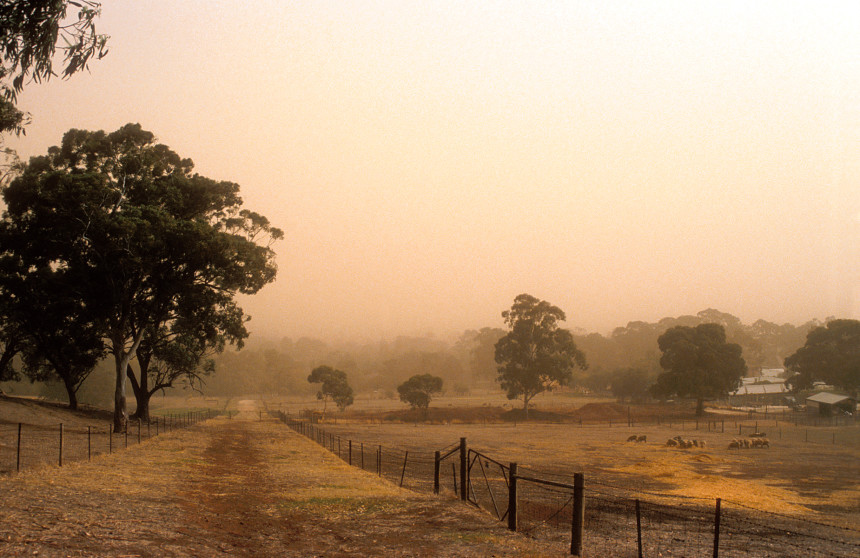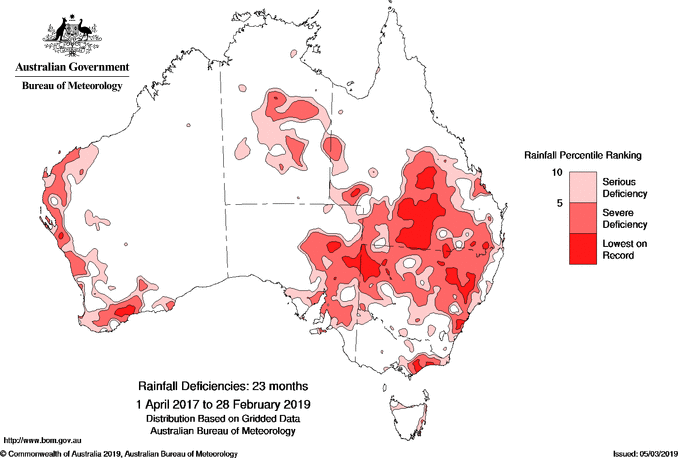State of the drought shows dams empty and NSW drowning in dust

It’s not good. Not good at all.
The hot dry summer has stripped the soils of moisture, water storages are down in every state and territory, and New South Wales is drowning in dust.
So far this drought has been short but hard-hitting. The coming cold season will be a test of that descriptor.
Last year’s national farm production was down on the bumper year of 2016, but a good year in the west, decent prices and some moisture last summer softened the blow.
But with widespread low soil moisture, the pressure is on the arrival of cool-season rain.
The heat is making things worse
Lynette Bettio, a climatologist at the Bureau of Meteorology, said the big dry was affecting large parts of NSW, eastern South Australia and parts of the Northern Territory and northern Western Australia.
And despite the flooding rains in the north, even Queensland isn’t off the hook.
“The floods largely missed those areas of drought that we were covering,” Dr Bettio said.
“It did relieve some of those areas; those large totals of rainfall meant that some areas near the border with the NT are no longer in that bottom 10 per cent for those [drought-measuring] periods.
“But there’s still large parts of southern Queensland that are in that bottom 10 per cent of rainfall and lowest-on-record rainfall for those 11-month and 23-month periods.”
“We’ve just come off a record-warm summer, and that extreme heat that we saw, especially those heatwaves in December and January, certainly exacerbated those drought conditions and really added to the intensity of the impacts.”
And the coming months aren’t looking good, Dr Bettio added.
“For autumn, for rainfall, there’s really an increased chance of below-average rainfall across much of eastern Australia.”
The dams and the damned
A mostly dry northern wet season (torrential flooding in Queensland notwithstanding) and last winter’s dismal rain in the south, has resulted in depleted water storages in every state and territory compared with this time last year.
New South Wales is the lowest at just 27.8 per cent of capacity overall, which is grim, but it gets worse when you look at individual dams.
Tony Webber from WaterNSW said it was a “very serious situation”.
“I’ve been in the water sector for 11 years; I’ve never seen a dam run dry and that’s the situation in Keepit,” he said.
Keepit Dam on the Namoi River, north-west of Tamworth, all but ran dry at the end of 2018.
“Menindee Lakes in the far west is in a similar predicament,” Mr Webber said.
“Releases into the Lower Darling have ceased. In fact, the Barwon-Darling River system itself has all but ceased to flow.”
The pipeline to supply water to Broken Hill directly from the Murray, rather than the Menindee Lakes, got switched on last month.
The problem is widespread.
“Most northern dam storages are in single figures. Pindari, for example, is 3 per cent in the centre of the state,” Mr Webber said.
“Burrendong Dam on the Macquarie River, servicing communities like Wellington, Dubbo, Nyngan and Cobar, is down to almost 7 per cent of capacity.
“It’s scheduled, under a continuation of this worst-case scenario, to run dry by as soon as early 2020.”
Around 40,000 people live in Dubbo.
Mr Webber said it was not only economically damaging but also exacted an emotional toll on the communities reliant on that surface water.
“Many of those small communities are now dependent on groundwater where that’s available, but the situation for landholders not on regulated systems has been very, very dire for quite some time,” he said.
“Now we’re seeing a similar situation for even stock and domestic entitlement holders on rivers that are served by a dam.”
At least the more metropolitan areas of New South Wales are doing better — Sydney is sitting around 57 per cent of capacity and its desalination plant is up and running.
Moisture buffer gone
Obviously the situation depends on where you are. Some areas in Western Australia had a record crop in 2018.
Department of Primary Industries agronomist and farmer Rohan Brill got a crop out of his property in the NSW Riverina last year, thanks mainly to moisture already in the soil.
Rain in December 2017 gave Mr Brill a buffer that, when combined with good prices, compensated for the dry winter and spring.
But the hot summer means that soils are dry and that buffer is gone.
“I think in general, most of southern New South Wales would be behind this time last year,” Mr Brill said.
Northern New South Wales, he said, was probably at a similar level as last year, but only because last year was equally bad.
So what do you do, sitting on dry land with a bad forecast?
Step one is to hope for rain.
Remembering past years that looked bad but came good is probably beneficial for morale, given the current bad outlook.
“I know in 2016, it was very dry through autumn and quite hot and we took a long time hanging on for rain,” Mr Brill said.
“It rained probably toward the end of autumn in 2016 but then it just kept on raining, so I think that’s the hope of everyone around.”
Then, there is lots of contingency planning — what to plant when, and if, it rains.
“I’ve heard people talk about not growing crops like canola because they’re higher risk, but in some ways, a crop like canola can actually be cheaper to grow,” he said.
“If you’ve got a lot of weeds it’s quite expensive to control in a wheat crop, but in canola it’s much cheaper to control the weeds.”
Finding savings elsewhere is also important. Mr Brill said doing soil tests to know what was really needed could be beneficial.
“Historically my grandfather and my father have been putting out a lot of phosphorus into the soil,” he said.
“The virgin country has very low phosphorus, but we are actually at a point now where the phosphorus reserves have been built up quite well.
“So it’s one of those inputs that we could potentially cut back on this year.”
Tests done by some of Mr Brill’s colleagues suggest that soils where phosphorus has built up over generations can comfortably handle phosphorus fertiliser being cut back by two-thirds.
“If a grower puts, say, 100 hundred kilos of MAP [fertiliser] on their crop, you’re talking $75 a hectare … so cutting back by fifty-odd dollars a hectare on phosphorus alone. It’s those types of things.”
In dry years Mr Brill said it was important not to forget the basics.
“I think it’s fairly important too that we still stick to the plans and to the rotation, so we don’t dig ourselves into a bigger hole for future years.
“It’s just making sure we don’t throw the baby out with the bath water.”
A state drowning in dust
In the meantime there is another problem.
“The dust is our worst thing at the moment. It is just horrible,” Mr Brill said.
“As soon as we get a change of weather coming in from the west, it just whips up a heap of dust from paddocks west of here and it just rolls in on dust storms.
The long-term issue is the loss of top soil.
“Just tonnes of soil being blown out to sea,” Mr Brill said.
“Topsoil doesn’t recover overnight, that’s for sure. It takes decades to build up.
“You can see paddocks around here now, even some of the areas that are fairly safe really look awful because it’s been so intense and come on so fast, they haven’t really destocked quick enough.
“So yeah, let’s hope for gentle, soaking rain for a few days, about anytime now, things will pick up.”
Let’s hope.
Originally published by the ABC, 12 March 2019.


